Handwritten manuscript in tablature for organ (Sign. XIII c3, S 73-90) found at the Kloster Marienberg, Helmstedt Germany by Thomas Synofzik
 |
Duration: 10'00", 30 kB |
| Theme of Folie d'Espagne by Abel | © Synofzik and Concerto, used with permission |
|---|---|
 |
|
- Synofzik, Thomas
- Published in the magazine 'Concerto, das Magazin für Alte Musik', Vol. 145, July/August 1999 p. 24- 29
- Article with introduction, source and full score edited in modern sheet music with footnotes
- Score 3 p. 21 x 29 cm (original manuscript 17 x 10,5 cm example included in article)
- The magazine 'Concerto' can be found at: http://www.concerto-verlag.de

- Accademia del Piacere (Fahmi Alqhai, viola da gamba and direction,
Miguel Ángel Cortés, flamenco guitar, Rami Alqhai, viola da gamba,
Johanna Rose, viola da gamba,
Juan Ramón Lara, violone,
Vicente Parrilla, recorders,
Enrike Solinís, baroque guitar, theorbo and archlute,
Pedro Estevan, percussion,
Agustín Diassera, flamenco percussion,
David "Chupete", castanets
Joaquín Rodero, oud) 'Las idas y las vueltas, Spanish Baroque meets flamenco'
- Title: Folías - Various authors, c. 1700
- Released 2014 by Glossa compact disc ordernumber GCD P33203
- Duration: 5'36"
- Recording date: December 2011 and January 2012 in Estudios Sputnik in Sevilla, Spain
- Academia del Piacere
Folías by Accademia del Piacere live broadcasting
Duration: 4'34" direct link to YouTube
© 2012 by Accademia del Piacere- Title: Folías
- Broadcasted by RTSI (Radio televisione svizzera italiana) 10 July, 2012
- Duration: 4'34"
- Recording date: live concert (program 'Fantasias, diferencias y glosas') 13 April 2012 during the Festival d'Estate, Sala Sopracelerina in Locarno, Swiss
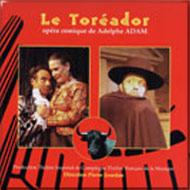
The opera, which had its premiere in May 1849, is loaded with hidden meanings, subtly describing ambiguous relations and misunderstandings between the three characters Don Belflor, his wife Coraline and her lover Tracolin.
Beside the well-known 'Ah vous dirais-je maman' ('twinkle twinkle little star') there are three famous Spanish melodies briefly introduced (the Fandango, the Cachucha and the Folies d'Espagne). These Spanish melodies are a set of conventions between Tracolin and Coraline how seriously Don Belflor has cheated his wife.
The Folia is played twice in act two, when Tracolin and Coraline agree upon which melody Tracolin will play in case Don Belflor cheated his wife badly. And in the finale, while Coraline reveals the reality with a deck of tarot cards, the Folia is played indeed to indicate Don Belflor's misbehaving.
 |
Duration: 0'32", 773 kB. (128KB/s, 44100 Hz) |
- Orchestre français Albéric Magnard conducted by Jean-Luc Tingaud 'Le Toréador, opéra
comique de Adolphe Adam' with Ghyslaine Raphanel (Coraline), Matthieu Lécroart (Don Belflor) and Franck Cassard (Tracolin).
Artistic director Pierre Jourdan.
Text: (while Coraline shuffles the deck of tarod cards to see, or might we say in this case better 'hear', the truth)
Coraline: Non pas, jusqu'au bout. Je vous dirai tout.
(Elle continue. Trancolin joue les Folies d'Espagne) Dieu! Qu'ai-je vu ! L'infâme vient, á ses pieds, de trahir ses serments !
Don Belflor: Ah ! je suis perdu ! Pardon, ma femme.
Translation into English:
Coraline: Not at all, I'm going to tell you everything, right to the end.
(She continues. Tracolin plays the Folies d'Espagne) Heavens! What's this! The horrid man, at her feet, has just betrayed his vows!
Don Belflor: Ah! I am lost! Forgive me, my wife.
- Title: Folies d'Espagne
- Released 2005 by Mandala compact disc Man 5098 distributed by Harmonia Mundi HMCD 90
- Duration: 2 fragments of quoting the Folia-theme less than 0'20" in 'Air de tracolin' (7'21") and Final (8'52")
- Recording date: Live in front of an audience June 2004 in Théâtre Impérial de Compiègne
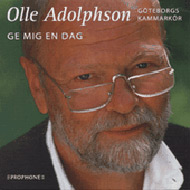
- Adolphson, Olle (vocals and guitar) and Gothenburg Chamber Choir conducted by Gunnar Eriksson 'Ge mig en dag'
- Title: Folia (Rim i juli)
- Originally released 1983, re-release 2004 by Prophone compact disc PCD072
- Duration: 2'20"
- Recording date: 1983


This is a very popularized Folia. It was released as the A-side of a single. I don't know if it hits the charts in the seventies. The music is interesting in more than one way. The instrumentation is extraordinary. Besides the violin as the lead-instrument played by Igal Shamir, in the second and third variation a drumkit and an mood synthesizer is introduced, making it into a sort of James Last-tune.. Next to the instrumentation the structure is of interest. The last eight bars of the Folia-theme (ending in the tonic) are played three times but the theme is extended with another nine bars. The first eight bars are a kind of answer to the folia-theme somewhat similar as in the lampaanpolska. The ninth bar is the bridge towards the second line of the Folia-theme. Although I could not find the company to ask for permission to put a fragment of the music at the site it is just too curious not to introduce it.
- Shamir, Igal (violin) and orchestra
- Title: La Folia
- Released 1970 by Polydor Brussels as a single 45 vinyl recording 2051 048 and 45 vinyl recording AZ SG 298
- Arranged by Bill Ador
- Duration: 2'50"
- Recording date: not mentioned at the cover or label
Both the name of the composer and the context of the music is not very clear. Sebastián de Aquirre is unlikely the be the composer and the piece was probably no part of a method. In this case it is classified as a piece by Sebastián de Aquirre because Los Otros (Lee Santana) made it famous as an improvisation on the cd "Aguirre". Eloy Cruz the musician who gave the manuscript to Lee Santana shared some background information about the manuscript including "Folias". The importance of this manuscript is definitely the location (Mexico) and the old age of the piece.
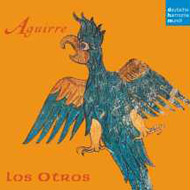 Eloy Cruz wrote about this source 16 January 2010 in an e-mail:
Eloy Cruz wrote about this source 16 January 2010 in an e-mail:
I gave Lee Santana (the author of the CD notes of "Aguirre" by Los Otros) all the info that I had about the MS, but it was several years before the making of this CD and I'm sure he had forgotten it, and I think his interests were somewhere else (hence the connection made by Lee between Sebastian de Aguirre -the supposed author of the MS- and Lope de Aguirre -the Spanish conquistador portrayed by Werner Herzog). Anyway, as long as I started this little Aguirre thing, I'd like to share with you some things I've learned of this MS; please don't take this as a criticism to Lee or anybody else, it's just my two-pence contribution for your wonderful page.
The Saldivar Codex 2 is a mexican manuscript for four-course cittern, or "cítara", discovered somewhere in Mexico by Dr Gabriel Saldivar y Silva (the same one who discovered the famous Saldivar Codex 4, the Santiago de Murcia baroque guitar ms), but both mss are not related to each other.
The Saldivar Codex 2 is undated, but was dated by Robert Stevenson as ca. 1650; in my opinion, because of its early repertoire (including Pavanas, Gallardas, Bacas and so on) and the lack of "modern" french pieces and menuets (always present in 18th century mexican mss), I think the Saldivar Codex 2 can be dated in the first half of the 17th century. Stevenson also says that the ms was written in the city of Puebla, in central Mexico, but he gives no reasons for this statement.
There are 2 names in the ms: Anttonio Marttin de Villegas and Sebastian de Aguirre, and I have found not one single piece of information about who these men were. There's no evidence that any of these 2 persons is the compiler or composer of the music, but then, apparently Dr Saldivar considered that the author was Aguirre and labeled the ms "Metodo de citara de Sebastian de Aguirre" and ever since Aguirre has been credited as the composer, and the MS considered a "method", which it is not. In fact, I think Anttonio Marttin de Villegas could be the author or compiler of the MS because his name is at the beginning of the ms. Aguirre's name appears only at the end in an acrostic (a very bad one) praising his nobility and making him some kind of a warrior or soldier, so I think Aguirre was the patron or boss of some guy who could or could not be a musician, called Anttonio Marttin de Villegas, but it's only guesswork.
I don't have the xerox copy of the MS with me, but according to my index,
there are only 2 folias in it, in f. 16v., headed: "folias por 6 y 7 rasgas" and "folias por elami rasgas." rasgas (last 2 letters in superscript) is an abbreviation for "rasgadas", strummed. This would mean
that only the basic folia chords are in the original, and all the rest of the music was composed by Lee Santana. As I tell you,
I don't have the xerox with me, I'll check it.
I use to say that Lee "reconstructed" the music of the MS, but in this case
he probably composed it. This folia was first recorded by Lee on the cittern and myself on baroque
guitar at the CD "Laberinto en la guitarra. El espíritu barroco del son jarocho".
- Ensemble Continuo (Lee Santana cittern, Eloy Cruz baroque guitar) 'Labyrinth in the Guitar'
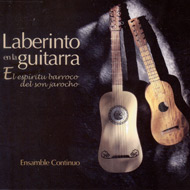 Eloy Cruz wrote about this Follia:
Eloy Cruz wrote about this Follia:
This is a very simple version, the one in the Los Otros Aguirre CD could be very different (I've never heard this CD), because as Lee says, they all were improvising.
- Title: "Folias"
- Released 2004 by Urtext Digital Classics (Mexico) compact disc UMA 2018
- Duration: 3'23"
- Recording date: unknown
- available in itunes and at http://www.classicsonline.com/catalogue/product.aspx?pid=786752
- Los Otros (Hille Perl: viola da gamba, Lee Santana: Mexican cittern, Steve Player: Xarana) 'Aguirre'
I really don't know in how far Aguirre is involved in this Folia-composition because in the documentation of the cd there is no detailed account for the sources of the manuscript, but I guess it will be catalogued as Aguirre's Folia in the future.
If I understand it correctly it will be a book with exercises how to play the Mexican cittern. It looks very plausible that a Folia is included because it was one of the most popular tunes in the 18th century, but I lost count how many different Folias the members of Los Otros has recorded so far. In the documentation is stated that the manuscript was more the vehicle to put together some improvisations and that is reflected in the music because there is almost no structure whatsoever in this Folia-tune. An acoustic mix of popmusic close to the Eagles and the Hidalgo brothers of Los Lobos (instead of Los Otros?) pops into my mind although the viola da gamba seems a very long way from home here.
Lee Santana wrote for the slipcase:
I locked myself in with a copy of the Manuscript, which is a very chaotic (typical cittern!) collection of chord charts and 'licks' for what must have been some of the hits of that era, a kind of 17th century fake book. There are no rhythmic indications whatsoever, and lots of mistakes all over (cittern!)., so I had a heyday making sense and nonsense out of these fragments. [...] The pieces are sketches; some bits of tunes, bass lines, chords, forms, sometimes germinal ideas for solos.
- Released 2004 by Deutsche Harmonia Mundi, BMG compact disc 82876 60489 2
- Duration: 6'30"
- Recording date: February 24-28, 2004 at Colnrade, Germany
- Tembembe Ensamble: Leopoldo Novoa ( marimbol, guitarra
de son, jarana huasteca, arpa llanera y tiple) ,
Enrique Barona (voz, huapanguera, jaranas, marimbol, leona, pandero y maracas), Eloy Cruz (guitarra barroca jarana barroca y tiorba)
Invitados: Ulises Martínez (violín, cajón de tapeo y voz), Ada Coronel (vihuela y voz), Andrés Flores (jarana y voz), Donají Esparza (baile tradicional) 'Diferencias e invenciones: Nuestro son barroco ' - Title: Folías from Códice Saldívar 2: Método de cítara de Sebastián de Aguirre, México, siglo XVII, reconstrucción: Lee Santana.
- Broadcasted by a Mexican Radiostation during the anual festival 2009 in Guanajuato which is a state very close to Zacatecas in Mexico. It is a mixture of everything, including dance, theatre and plain entertainment. Savall has been there several times.
- Duration: 2'27"
- Recording date: October 22, 2009 in Templo de la Valenciana in Guanajuato, Mexico
 In the announcement during the concert was stated:
In the announcement during the concert was stated:
La pieza que vamos a tocar ahora es de las pocas que estan... mas bien quiero decir que es un par de piezas: es una Folia que procede de un libro mexicano del siglo XVII que le dicen el Metodo de Citara de Sebastian de Aguirre, porque era para un instrumento que ya no se utiliza en absoluto que se llama citara y Leopoldo va a tocar la parte de la citara con este tiple Colombiano
Translation in English by Carlos E. Osuna:The piece that we are going to play now is one a the very few that...I really want to say that it is a pair of pieces: one is a Folia that comes from a 17th-century Mexican book named "Method for the Cittern (Citar) by Sebastian de Aguirre", because it was for an instrument that is now obsolete that was name Cittern, and Leopoldo is going to play the Cittern part on a Colombian tiple.
Eloy Cruz wrote about this concert 16 January 2010:
The version we played at the Festival Cervantino is basically the same as in
the Laberinto CD, but played on a 4-course, triple-strung colombian guitar
called "tiple", and blended with a Colombian piece called "La Guaneña".
This version has been very recently recorded in the CD: "Diferencias e
Invenciones. Nuestro son barroco", Tembembe-M Sonido (Mexico).
This last version is somewhat of a divertimento and I had forgotten all of
the Aguirre-Santana thing; sorry, I'll never again say that this piece comes
from Saldivar Codex 2.
Incidentally, in the Festival, after this folia, we played the Follia by A.
Corelli in a "Huasteco" versiona. Our fiddler, Ulises Martinez, is very well
acquainted with the music of the Huasteca region by the Gulf Coast of Mexico
(always played by one violin and 2 guitars, all tuned at A=415) and he said
that this Follia could very well be a traditional piece from this region in
Mexico.
There is little known about Luigi Agliati. He was very probably from Milan, for it is in this city in Lombardy that he pursued his activity as guitarist and composer for the guitar in the first years of the 1800's. Some of his works were published by Ricordi in the first decades of the century and amongst the highlights of his oeuvre most certainly belong his Folia-variations.

Birgit Schwab wrote about the piece in an e-mail February 11, 2010:
Each of the variations is written in the style of an important mandolin composer: No.1 Gabriele Leone, No.2 Carlo Munier, No.3 Heinrich Konietzny.
- Ahlert, Daniel (mandolin) and Schwab, Birgit (guitar)
Duration: 3'05" direct link to YouTube
Birgit Schwab and Daniel Ahlert playing Variationen über ein Thema von Corelli
© Birgit Schwab and Daniel Ahlert, used with permission- Title: La Folia
- Originally released on YouTube December 8, 2009 of a recording during a live concert
- Duration: 3'00"
- Recording date: July 4, 2007 in Herzogenrath, Germany.
- More about the oeuvre of this duo at their website http://www.ahlert-schwab.de/
 |
The complete sheet music |
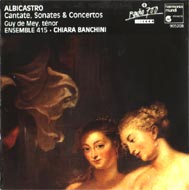
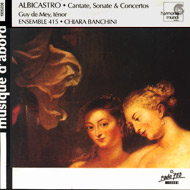 as the first one of the next variation. Gives a very nice drive to the music
(yes, this performance of Ensemble 415 is still my personal favorite of all the Folia performances after all these years, how did you guess?).
as the first one of the next variation. Gives a very nice drive to the music
(yes, this performance of Ensemble 415 is still my personal favorite of all the Folia performances after all these years, how did you guess?).Albicastro as an historical figure including playing his Folia stood model for a personage in the historical roman Secretum by Menaldi & Sorti.
- Banchini, Chiara (violon) Brugge, Hendrike ter (violoncelle) Murray, Gordon (harpsichord Dominique Laperle d'après Grimaldi) 'Albicastro: Cantate, sonates & concertos'
Jean-Yves Haymoz wrote for the slipcase:Ensemble 415 with Sonate pour violon et basse continue Opus 9, nr. 12
Duration: 11'32" direct link to YouTube. Still my personal favorite Folía and performance of all Folías.
© 1991 by Ensemble 415
His output consists of four opuses of trio sonatas for violin and continuo, one of Concerti grossi and a motet entitled 'Coelestes angelici chori' for tenor or soprano which has remained in manuscript form. The style is Italian and the fact that at the end of Opus V there is, like in Corelli, a 'Folia', is a wink that speaks volumes! Albicastro thus ranks among those southern German composers who drew much of their substance from the Italian style, such as Froberger, Walther or Sebastian Scherer
- Released 1991 by Harmonia Mundi compact disc HMC 905208, re-released 1998, series Musique d'Abord compact disc HMA 1905208
- Duration: 11'32"
- Recording date: January and June 1990 at the Studio Ernest Ansermet, Radio Suisse Romande
- Hortus Musicus 99 (Attila Feltein violin, Aino Oláh harpsichord, Bálint Maróth violoncello)
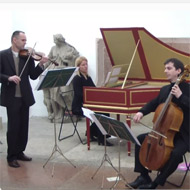 A Wonderful performance of an extraordinary piece.
A Wonderful performance of an extraordinary piece.
Hesperion XXI at You Tube
Duration: 13'47" direct link to YouTube
© 2012 by Hortus Musicaus 99- Title: "Folia, op. 5 nr. 6"
- Released April 2012 by Hortus Musicus 99 at YouTube
- Duration: 13'47"
- Recording date: April 2012
- More about this group at theit website http://www.hm99.hu
- Kraemer, Manfredo (violin), Ruiz, Mercedes (violoncelle), Behringer, Michael (harpsichord) 'Altre Follie'
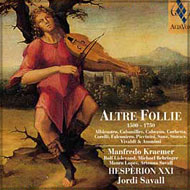
Like the performance of Ensemble 415 (Banchini) this performance is excellent and includes one more fast variation. I don't know if this variation was included in the original score but I suppose it was included by Kraemer cum sui. Otherwise I don't see any reason why Banchini left out this variation.Hesperion XXI at You Tube
Duration: 11'41" direct link to YouTube
© 2005 by Alia Vox
Rui Vieira Nery wrote for the slipcase:
In 1704 one of the most representative composers of violin music of the German and Dutch school, Henricus Albicastro, an artistic pseudonym of Johann Heinrich von Weissenburg (ca. 1660-ca.1730), published a sonata "La Follia", which displays a clear Corellian influence in its virtuosic writing.
- Title: Sonata "La Follia"
- Released 2005 by Alia Vox compact disc AV 9844
- Duration: 11'41"
- Recording date: February 28-March 3 and June 6-9, 2005 in the Collégiale of the Château de Cardona, Catalogne
- See also the page Recommended Folia-recordings
- Woods, Alexander "Corelli's influence, virtuoso works for baroque violin"
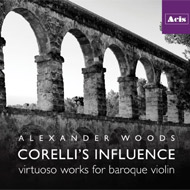 In the slipcase was written:
In the slipcase was written:
His Sonata op. 5, no. 6 is a 'Folia', not unlike Corelli's famous Sonata op. 5, no. 12. Albicastro's version is equally, if not more, virtuosic than his Corellian predecessor, and just as expansive and moving. One of its most curious and compelling features is the surprising series of reiterations of the final cadence. Biber-like effects also emerge occasionally in both the no. 6 and no. 4 sonatas. For example, the second movement of no. 4 and the final variation of no. 6 are both saturated with an effect Jaap Schroeder has observed in German music of the 17th century: the "perfidia pattern" or rhythmic ostinato (in both cases, distinctive dotted rhythms)
- Alexander Woods (violin), Ezra Seltzer (cello), Avi Stein (harpsichord)
- Title: Sonata, op 5, no 6, "Folia"
- Released 2015 by Acis compact disc oeder number APL59090
- Duration: 12'47"
- Recording date: August 19-21 2014, at the Dorothy Young Centre for the Arts, Drew University, Madison, New Jersey, USA
- Baroque violin built by Jason Viseltear in New York City, 2012
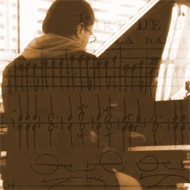
- Alcántara, Victor (piano)
Victor Alcántara , October 13, 2013
Duration: 6'53" direct link to YouTube
© 2014 Victor Alcántara- Title: La Folia - Follia - Folies d'Espagne, solo piano improvisation
- Released January 2014 at YouTube by Victor Alcántara
- Duration: 6'52"
- Recording date: October 13, 2013 during the Klavierfest Ammersee, Dießen, Germany
- More about the oeuvre of Victor Alcántara at http://victoralcantara.de/
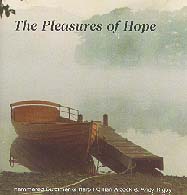
Gillian Alcock wrote in the slipcase about La Folia in OZ:
Many composers over the centuries have written sets of variations, suited to different instruments, based on the popular old Portuguese folk tune, La Folia. As far as I know, this is the first set written for dulcimer as it is tuned and played today.
She verified that she used the theme of the Barcelona Manuscript (1764) for salterio solo as the introduction of 'La Folia in OZ':I actually performed all the Barcelona variations in 1996. It was while practising for that concert that I made up my own variations for dulcimer. The different tuning layout makes a difference in the ease of playing ... the Barcelona set is easier on a salterio, mine are easier on a dulcimer tuned the way modern dulcimers are tuned.
All activities of this composer, builder, teacher and performer can be found at http://www.netspeed.com.au/gillian.alcock- Alcock, Gillian (hammered dulcimer) 'The Pleasures of Hope'

Duration: 1'47", 264 kB. (20kB/s, 16KHz)
Theme and first variation
© Gillian Alcock 1997, used with permission- Released 1997 by Alcock compact disc GA001.
- Duration: 6'29"
- Recording date: 1997 in Canberra, Australia.
- Instrument (hammered dulcimer) built by Gillian Alcock.
- Released 1997 by Alcock compact disc GA001.
 |
Duration: 4'50", 13 kB. |
The Folia progression takes 4 bars only because the piece is written in 5/4 meter. Don't let yourself distracted by the accent on the 5th count of every bar. Dividing up the 5/4 meter bars into 3/4 and 2/4 meter will help to spot the theme:
| The Folia progression in A minor by Alkan in 5/4 meter | |
|---|---|
 |
|
* The f in the g7 chord may be considered as the descending connection from g to e
** The e7 chord (dominant 7th) may be considered as a substitution of the g chord in front of the tonica (am)
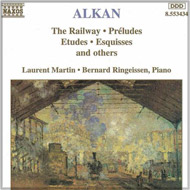
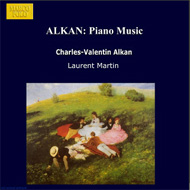
- Martin, Laurent (piano) 'Alkan: The railway, preludes, etudes, esquisses and others'
and re- release 'Alkan Piano Music'
- Released 1995 by Naxos compact disc 8 553434, re release 2009 by Marco-Polo compact disc 0730099365727
- Duration: 4'47"
- Recording date: 1989-1992 in Studio Clara Wieck Auditorium, Heidelberg, Germany
José Alberto Alonso wrote in an e-mail Mauy 2025:
I am contacting you because I recently composed a piece on follies and I would like the reference to appear on your website. This minimalist piece consists of six “diferencias” (variations) on the theme of follies for two players. Each variation is made up of a series of figures or cells that are repeated “ad libitum” before moving on to the next.
It is an open-ended piece in terms of instrumentation (it can be played on any two period, modern, traditional… instruments) and duration.
| Opening of Folías (Diferencia 1) | |
|---|---|
 |
|

- Accademia del Piacere 'Spain On Fire'
- Title: Folías de España
- Released March 2025 by Challenge Classics
- Duration: 4'18"
- Recording date: unknown

Ronald Martin Alonso wrote about Folias Americanas
It was composed in 2012 for one viola da gamba and one harpsichord and this arrangement for three violes was composed in 2019 by the composer himself.
- Ensemble Vedado: Calia Álvarez, viole de gambe Lixsania Fernandez, viole de gambe Aland Lopez, guitare baroque Gabriela Mulen, clavecin Reinaldo Ponce, percusisons Ronald Martin Alonso, viole de gambe et direction
- Title: Folias Americanas sur le thème des Folies d'Espagne|: I Thème 1'01, II Tango congo 0'56, III Bossa nova 1'05, IV Bolero 1'10, V Chacarera 0 '45, VI Mambo 0'46, VII Vidalita 1'14, VIII Vals campero 0'52, IX Rythm and Blues 1'12, X Tango 0'49, XI Conga de Carnaval 0'41, XII Blues 1'43, XIII Son 1'58
- Released March 2024 label Paraty
- Duration: 6'21"
- Recording date: unknown
- More about the oeuvre of Ensemble Vedado at https://www.ensemblevedado.com
Ensemble Vedado, February 5, 2019
|
 With a reference to Arcangelo Corelli in the title, the composer who wrote the most famous Folía variations, the tune starts with an eastern improvisation before the rather traditional Folía tune sets in.
With a reference to Arcangelo Corelli in the title, the composer who wrote the most famous Folía variations, the tune starts with an eastern improvisation before the rather traditional Folía tune sets in.
- Ensemble Oni Wytars 'La Follia, the triumph of Folly'
- Title: Follia d'Arcangelo
- Released 2013 by Deutsche Harmonia Mundi compact disc 88765449782
- Duration: 3'14"
- Recording date: October 1-3, 2011 in Kurtheater, Bad Kissingen, Germany
- See also recommended recordings
 Matteo Andri wrote in an e-mail January 5th, 2018
Matteo Andri wrote in an e-mail January 5th, 2018
Years of composition: 2013-17 (I'm still working on it, 'cause every time I'm going to play it I change something...the order of the variations, some technical passages and other things).
| Opening of Dodici Variazioni | © Matteo Andri, used with permission |
|---|---|
 |
|
- Andri, Matteo
- Title: Dodici Variazioni sul tema de "La Folia"di Spagna
- Published 2017 by Marreo Andri
- Duration: ca. 11'00"
- More about Matteo Andri at his website http://www.matteoandri.webs.com/

As a source of this work is given:
A traditional Spanish/Italian dance that exists in many Latin American sources. Our version, arranged by Julie Andrijeski, uses some Mexican and Spanish sources, as well as some variations based on Corelli and Vivaldi.
- Chatham Baroque 'Sol y Sombra, Baroque music of Latin America'
Andrijeski, Julie (violin), Davidson, Emily (violin), Halverson, Patricia (viola da gamba), Pauley, Scott (theorbo, baroque guitar and archlute)
Scott Pauley wrote for the slipcase:Folias
Duration: 8'27" direct link to YouTube published by EFN84's channel
© 1998 by Chatham BaroqueThe Folias performed by Chatham Baroque attempt to recreate an improvisatory feeling over a repeating ground bass pattern. Using sources from both the Old and New World, Julie Andrijeski has created a unique version of this well-known dance.
- Released 1999 by Dorian Recordings compact disc DOR-90263
- Duration: 8'27"
- Recording date: March & April 1998 at the Troy Savings Bank Music Hall in Troy, NY
Ms. in Deutsche Staatsbibliothek Berlin, Mus Ms. 30 206 p. 40-44
Ms. in Bibliotheca National Madrid, s-89ter nr. 21
 |
9 pages in pdf with all 22 couplets, 129 kB |
D'Anglebert follows the form of the later (as opposed to the early diverse one) folia
closely, but varies the final cadence by using submediant
or subdominant harmonies. His 22 variations constitute an
early instance of keyboard melodic variations. The form
is defined as having a generally fixed harmonic scheme and
constant formal proportions; the main notes of the melody
are retained but may be embellished in any number of ways by
addition of nonharmonic tones and rhythmic variation. The
melody of d'Anglebert's Variations undergoes continual alteration
in the soprano voice, supported by the harmonic structure and
fluent movement of the lower voices. Since D'Anglebert adheres
to the constraints of the form, the harmonies are simple. Occasionally
the rhythmic interest shifts to a lower voice or voices, or a
distinctive rhythmic pattern may be tossed between the hands,
as in Variation 16. In Variation 21 the melodic notes are trilled
with alternating upper and lower auxiliaries, almost producing the
effect of a continuous trill. The scale and arpeggio pattern in the
bass of the last variation resemble the Italianate violin style.
Although numerous settings of the folia melody occur in French
manuscripts of the period, D'Anglebert's Variations are possibly
the first published keyboard melodic variations on the folia, preceding
those of Pasquini (in manuscript from the 1690s),
Alessandro Scarlatti
(1715) and C.P.E. Bach (1778). D'Anglebert's Variations had great
popularity and longevity, for they are also found in a late eighteenth-century
German manuscript. They reflect characteristics of the Italian school-notably
those of Bernardo Pasquini.
D'Anglebert's Variations also fall into this classification of melodic variations,
with a homophonic texture and fixed harmonies, and they appear to antedate those
of Pasquini. Whatever the case, D'Anglebert was probably influenced by the Italians,
for traits such as violinistic gestures occur. His Variations, however, do not
reflect the virtuoso style, sharp contrasts , and vivid imagination of those by
Marais. One senses that Marais's variations were for the pleasure of a seated
audience, while D'Anglebert's could have accompanied dancers and may have been
included in his edition for their populair appeal. Although simply constructed,
these variations succeed admirably within their strict harmonic and formal
framework.
 |
Duration: 0'34", 02 kB. |
| First 8 bars of the opening-variation by d'Anglebert | by unknown source |
|---|---|
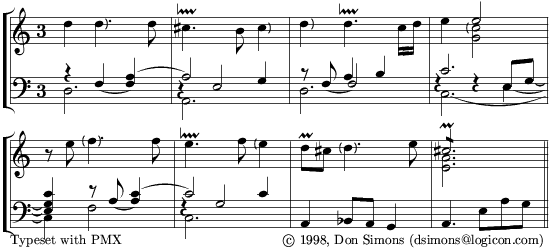 |
|
- Published 1965 by Broude Brothers, New York
- Titel: Pieces de Clavecin, facsimile of the 1689 Paris edition
- Part of: Monuments of music and music literature in facsimile, First series Music IV
- 11 p. (page 88 till 98), 29 cm
- Farr, Elizabeth (harpsichord solo) 'Jean-Henri d'Anglebert, Suites de clavecin'
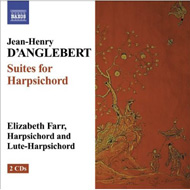 Elizabeth Farr wrote for the slipcase:
Elizabeth Farr wrote for the slipcase:
The Suite in D minor is a large suite that opens with a prelude non mesure twice as long as those of the previous suites, moving forward with excitement and anticipation.
The suite is capped by a set of22 variations on the Folies d'Espagne. The word folia, a popular ground that originated in fifteenth-century Iberia, literally means "insanity" in Portuguese. A wild, churning dance song, it was used as the basis of improvisations and virtuoso compositions. Its influence can be felt throughout this suite, in which the key of0 minor carries affects ofdevotion and grandeur, melancholy and phantoms- Title: Variations sur les folies d'Espagne
- Released 2008 By Naxos 2x compact disc-set 8.570472-73
- Duration: Variations sur les folies d'Espagne: Couplet 1 Couplet 1: 0':54", Couplet 2: 0'28" Couplet 3: 0'30", Couplet 4: 0'30" Couplet 5: 0'30", Couplet 6: 0'20", Couplet 7: 0'30", Couplet 8: 0'30", Couplet 9: 0'28", Couplet 10: 0'29", Couplet 11: 0'31", Couplet 12: 0'31", Couplet 13: 0'29", Couplet 14: 0'52", Couplet 15: 0'29", Couplet 16: 0'29", Couplet 17: 0'28", Couplet 18: 0'29", Couplet 19: 0'29", Couplet 20: 0'33", Couplet 21: 0'29", Couplet 22: 0'37"
- Recording date: August 2007 at Ploger Hall, Manchester, Michigan, USA
- Harpsichord: The lute harpsichord used in this recording is oneKeith Hill made in 2000 using a description found in Adlung's Musica Mechanica Organoedi (I768) of a lautenwerk made for J. S. Bach based on his special requirements. Tuning a' 415 Hz
- Gammie, Ian arranged Les Folies d'Espagne for three bass viols with
optional figured bass continuo for lute, keyboard etc.
- Published 1990 by Corda Music Publications http://www.cordamus.demon.co.uk/
- Part of: French music for Viols
- Score viol parts 4 p. each, basso continuo (partly realized) 8 p., size A4 - 210 x 297 cm
- One of the viols needs a low A-string in French style.
- The number of variations: 21 Couplets after the main theme, the ornamentation is mostly reduced to standard gamba ornament signs.
- Publisher No. CMP 406
- Gammie, Ian arranged Les Folies d'Espagne for three violas with optional
figured bass continuo for lute, keyboard etc.
- Published 1997 by Corda Music Publications
- Score viola parts 4 p. each, basso continuo (partly realized) 8 p., size A4 - 210 x 297 cm
- The number of variations: 21 Couplets after the main theme, the ornamentation is mostly reduced to standard gamba ornament signs.
- Publisher No. CMP 637
- Kim, JungHae (harpsichord solo) ' D'anglebert pieces de Clavecin 1689 Paris'
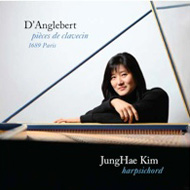
- Title: Suite No 3 in D Minor - Variations (couplet 1-22) sur les folies d'Espagne
- Released 2010 by Magnatune compact disc
- Duration: 10'25"
- Recording date: unknown
- Nyquist, Kristian (harpsichord solo) 'Jean-Henri d'Anglebert, pièces
de clavecin'
 Kristian Nyquist wrote about Les Folies d'Espagne in the slipcase:
Kristian Nyquist wrote about Les Folies d'Espagne in the slipcase:
The triumph of the Folies d'Espagne started probably around 1656 after the appearance of the guitarist Francecsco Corbetta in Paris. The name is derived from, the Portuguese "folias", meaning lunacy. It originated from a noisy, very fast carnival dance of fertility and slowed down in the course of time. The wonderful melody enhanced its popularity throughout all of Europe. d'Anglebert's variations, maybe the first published version for keyboard, are not so much on the virtuoso order as the ones by Marais, Corelli or Vivaldi, but can be well imagined to have served for real dance occasions. Yet, in this form it survived its creator and even still is found in a German manuscript from the late 18th century.
- Title: Variations sur les folies d'Espagne, edition J.-H. d'Anglebert Pièces de Clavecin, editor Kenneth Gilbert, published by Heugel, Paris 1975
- Released without any indication of the year by Etoile Production Sabam TM compact disc EDPO311
- Duration: 10'53"
- Recording date: October 1998 in Centre paroissial de Boom, Belgium
- Temperament meantone
- Harpsichord made after Italian models by Colin Booth, Wells, 1993
- Rousset, Christophe (harpsichord solo) 'd'Anglebert, complete harpsichord
works (2 cd-set)'
Duration: 9'12" direct link to YouTube
Christophe Rousset plays Folies d'Espagne
© Decca records
- Title: Folies d'Espagne (grouped under pieces in D minor)
- Released 2000 by Decca compact disc 458 589-2 79.04 and 458 590-2 79.35
- Duration: 9'08"
- Recording date: Sept. 27 till Oct. 10, 1996 in Musée d'Unterlinden in Colmar
- Ruckers harpsichord from the Musée d'Unterlinden in Colmar
- Pitch a'= 392, temperament: meantone.
- Stolz, Ernst (viola da gamba) and Smagge, Karel (harpsichord)
 This looks more like an arrangement of the Folies d'Espagne by Marin Marais but some variations of 'd'Anglebert are incorporated for the harpsichord.
This looks more like an arrangement of the Folies d'Espagne by Marin Marais but some variations of 'd'Anglebert are incorporated for the harpsichord.
Duration: 8'33" direct link to YouTube
Ernst Stolz (viola da gamba) and Karel Smagge (harpsichord)
© Ernst Stolz and Karel Smagge, used with permission- Title: Variations sur les Folie d'Espagne after Jean-Henry d'Anglebert
- Released at YouTube April 9, 2010
- Duration: 8'33"
- Recording date: during a live concert April 8, 2010 in Den Hague, The Netherlands
- Tomás, Pilar (harpsichord) 'Obras para clave'
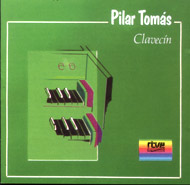 Pilar Tomás wrote about Les Folies d'Espagne in the slipcase:
Pilar Tomás wrote about Les Folies d'Espagne in the slipcase:
The suite in d-minor ends with the set of variations on 'La Folia de Espana'. These are the only variations on this popular theme composed for a keyboard instrument in France during the 17th century*. 'Folia' meant 'madness' in Castilian [the standard literary form of Spanish], and it was originally used to refer to a very fast dance, 'out of control' ['alocada' means literally with madness but it really implies 'beyond the standards or beyond the reasonable framework']. Little by little, the dance becomes slower (being assimilated as a courtly dance). D'Anglebert variations are 22 pieces of notable 'richness'. Within their scope we discover different styles: Italian, French... The [contemporary] baroque choreographies (cf. Feuillet) justify the use of changes in tempo and character.
* In 1998 there was another long forgotten manuscript of the Folies d'Espagne for harpsichord published of minor importance and which was originally collected by Marc Roger Normand (1663-1734) in 1695.
- Title: Variations sur les Folies d'Espagne
- Released by RNE compact disc RNE M3/08
- Duration: 9'53"
- Recording date: 4/9 October, 1990 in Estudios Música 1 de la Casa de la Radio (RNE), Madrid
- Tramier, Brigitte (harpsichord) with Philippe Foulon (viola da gamba) and Alain Boucho (percussion) in Folies d'Espagne 'J.B. Lully, J.H. d'Anglebert, Les songes agréables d'Arys '
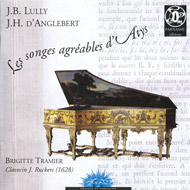
- Title: Les Folies d'Espagne
- Released 2002 by Parnassie éditions compact disc 3 361 540 151 100
- Duration: 12'24"
- Recording date: April 30-May 2, 1999 in les galaries historiques du XVIIème siêcle au Château de Versailles, France
- Harpsichord: J. Ruckers (1628)
- Willi, Barbara Maria (harpsichord) 'Jean Henri d'Anglebert, Sämtliche Cembalowerke Vol. 2'
 Barbara Maria Willi wrote about Les Folies d'Espagne in the slipcase:
Barbara Maria Willi wrote about Les Folies d'Espagne in the slipcase:
From among the pieces in the appendix, which encompasses all those movements not included in Part 1 of my complete recording, I would like to single out one that in terms of size and form is unique among d'Anglebert's original works for harpsichor: the variations on the famous Follia bass. As a mosaic of many dissimilar parts, the twenty-two couplets represent a great challange to the player.
In my opinion, the Follia variations are d'Anglebert's most 'Italian' work. Besides French style cantabile sections dominated by the upper voice, elements of the Italian style can also be found: variations with rhythmici ornamental figures and a clear alternation of regular motion between the bass and the soprano. The long series of small character sketches finally leads into a flashy solo in the left hand, which is accompanied in the right hand by chords enriched with acciaccaturas. The master arranger, the great protagonist of beautiful gaillardes, and creator of weighty sarabandes thus shows himself also to be a master of inventiveness and instrumental diversity. Let us hope that also from this recording he may be recognized as such.- Title: Variations sur les Folies d'Espagne
- Released 1999 by Musicaphon compact disc M 56828
- Duration: 9'18"
- Recording date: August 1998 in Schloss Bystrice pod Hostýmem
- Edition Kenneth Gilbert, Paris Heugel & Cie

David Arditti wrote about his composition (June 2002):
It had not occurred to me that my 'Song Without Words no. 2' was a variation
on 'La Folia' . You are right that it is, in the sense that it has the Folia
chord structure as it's basic idea, though the main difference between it
and all the Folias I see on your site is that it is in 4/4 time.
None of the people who have heard the piece before, including musicians,
have notice the resemblance to La Folia. This piece was described as
'Gypsy-sounding' by one listener, and 'resembling Fauré' by another - quite
a range.
I think the universality of the Folia chord-progression lies in the way it
is rooted in the minor but makes a central aspiration to the relative major
before dying back again. It is a kind of musical equivalent of a cycle of
life in its most simplified form.
I took this chord-progression from the general background of our musical
culture rather than in any deliberate attempt to write a variation on La
Folia, for one number in a set of romantic, short piano pieces that use the
title that Mendelssohn invented, and which re-interpret some techniques of
the cantabile piano style.
- Arditti, David 'Songs With and Without Words'

Duration: 2'05", 12 kB.
Theme and all variations as sequenced by David Arditti
© David Arditti, used with permission- Released 1999 by Menelik Music, 16 Menelik Road, London NW2 3RP, UK, e-mail menelik@darditti.com
- Duration: 2'17"
- Recording date: May 2, 1999 at Stanmore Church, Stanmore, London, England
- Arditti, David '6 Songs Without Words'
- Sheet music published 1998 by Menelik Music, 16 Menelik Road, London NW2 3RP, UK, e-mail menelik@darditti.com
- 3 pages (The whole set of six is 17 pages of A4)
It is rather doubtful if the Folia-theme is involved but since the composer did not react on an inquiry by e-mail I better list it briefly.
- Symphonieorchester des 50. Festivals junger Künstler conducted by Ferenc Gábor
- Title: FOLIE für Orchester
- Published sheet music by Sikorski
- Instrumentation: 3(Picc, AFl),3(EnglHorn),3(BKlar),3(KFag) - 4,2,2,0 - Pk (4), 2 Schl (Glsp, Xyl, Vibr, Holzbl5 Tom-t, Tamb, kl.Tr, gr.Tr, hg.Bk, Glsp, Xyl, Vibr), Harfe, Streicher (12/10/8/8/6[3 Fünfsaiter])
- Duration: 13'00"
- Recording date: Premiere August 27, 2000 in Bayreuth, Germany
